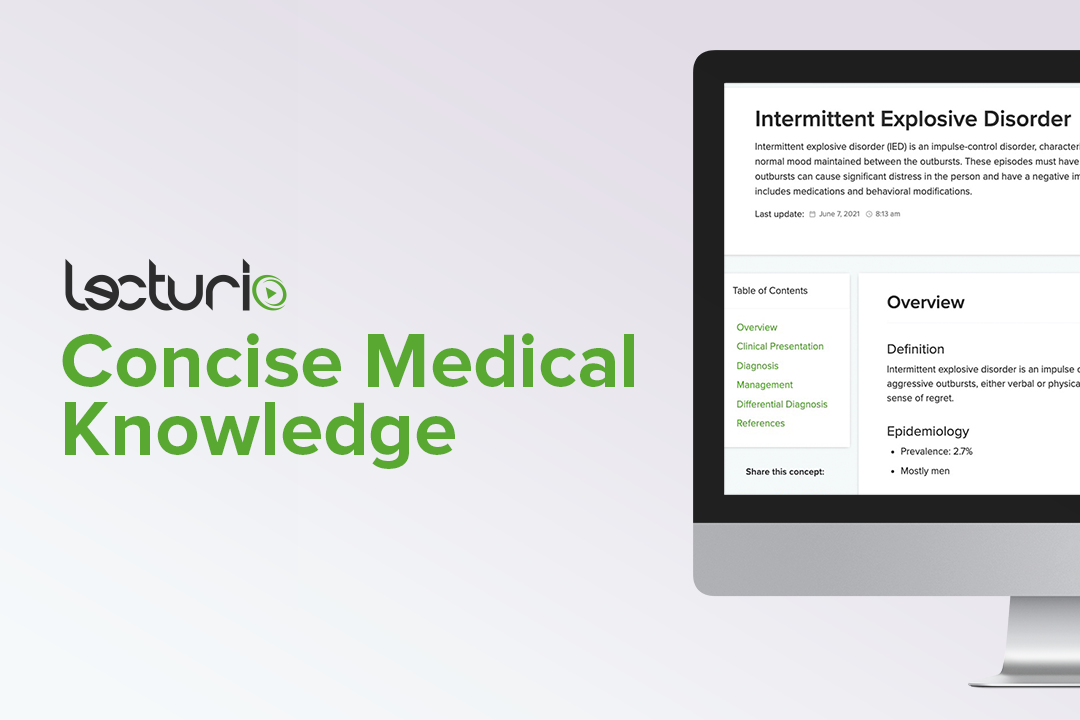Playlist
Show Playlist
Hide Playlist
Intermittent Explosive Disorder (IED)
-
Slides Impulse Control Disorders-Intermittent.pdf
-
Download Lecture Overview
00:01 Let's go into intermittent explosive disorder in more detail. 00:04 So there are problems here controlling emotions and behavior and it can result in behaviors that actually do violate social norms in the rights of others through verbal or physical aggression. 00:16 It's unplanned and it's usually out of proportion to any kind of provocation. 00:22 Sometimes there's no trigger at all and this causes distress and actual psychosocial impairment to the patient. So even though they get a release and sense of catharsis after performing an act, it also disturbs their conscience and they feel bad about it afterwards. 00:40 So, let's look at this man who's had an aggressive outburst, a clinical case example. 00:45 He's 25 years old and is repeatedly aggressive and assaultive to property. 00:51 Afterwards he describes feeling like, 'I was out of control' and he actually expresses remorse and apologizes for his actions. There's never a trigger that justifies the extreme nature of his aggressive outbursts. So, what actually distinguishes this man in this case from an impulse control disorder versus an antisocial personality disorder that you've learned about in another lecture? So, do you think it's because of the assault on property, feeling out of control, or his expression of remorse for events? Well, although patients with impulse control disorder can feel out of control, that's not necessarily different from antisocial but what is different is that the impulse control disorder patient will in fact express remorse and usually apologize or feel bad after their act unlike with anti-social personality. 01:49 So, here are some statistics about intermittent explosive disorder. 01:54 It's more common in men, usually comes on in the late teens, there's often a genetic, perinatal, environmental, and neurobiological factor that may play a role in the cause. 02:04 Patients may have a history of child abuse, head trauma, or seizure disorder, and it can progress in severity until middle age. The co-morbidities, illnesses that often come along with intermittent explosive disorder include, major depression, alcohol use disorder, substance use disorder, social phobia, specific phobia, also generalized anxiety disorder, PTSD, oppositional defiant disorder, conduct disorder, and attention deficit hyperactivity disorder. 02:39 The pathogenesis tends to be multifold. So, what about genetics, is there a link? Although exact genes are not identified, there is likely a genetic component because we see this running in families and in terms of neurobiology, impulse and aggressive behavior has been conceptualized as an imbalance between excessive aggressive drives originating in the limbic structures, brain areas such as the amygdala, and also insufficient control of these impulses by cortical structure such as the orbital frontal cortex and the anterior cingulate cortex. 03:19 Well, low levels of serotonin are associated with impulsiveness and aggression, a very important point that sometimes comes up on exams. 03:29 And then there are also psychological factors that play a role. 03:33 So, these can include a disruptive family environment, exposure to multiple traumas, and these all can play a role in the development of an intermittent explosive disorder. 03:45 So let's go back to our case example of this man who gets out of control and destroys property, and then feels bad afterwards. How would you go about assessing him? Well, here are some of the things you're gonna look for in a diagnosis. 03:58 So, you're gonna wanna know what thoughts or feelings immediately precede the outburst and you're gonna ask about things like if he's feeling rage full or irritable and whether or not there are any physical symptoms that are happening as well, like if he's having some heart palpitations or chest tightness. 04:17 You're gonna wanna know about the magnitude of the provocation or trigger. 04:23 Was it major or minor? And you wanna know about physical violence. 04:27 This ranges from low intensity to high intensity and you wanna explore more what's happening with your patient. Also, ask about a history of verbal outbursts, if there are arguments that frequently lead to physical assaults or loss of temper. 04:40 Ask about destruction to property and also, ask how long these incidents last. 04:47 Explosive outburst will typically last less than 30 minutes and then immediately afterwards, the patient will describe feeling relief and the outburst is over. 04:58 And you wanna know what that feeling was immediately after the outburst happens. 05:03 Did the patient feel sad, fatigued, its tired, embarrassed? So, these are all important assessment questions to explore. 05:11 Also, you need to ask about self-harm whether or not there's been superficial cutting with any kind of blades, whether or not a patient has been harming themselves, whether or not they've maybe been burning themselves with cigarettes. 05:26 Ask about suicide attempts. Among patients with intermittent explosive disorder, there can actually be an increase in suicide attempts so always screen your patients for risk of this, and also ask about non-suicidal injury. So any self-injury that wasn't intended to cause permanent harm but was still present. So, we know about this case and let's say this man, this 25 year old, has come in to see you and he tells you after your assessment that you know, his behaviors are really disrupting his friendships and that's bothering him, his family doesn't wanna talk to him as much anymore, and he finds himself really upset by this because he wants to be a part of events and part of people's lives. He isn't sure what's wrong with him and asks, 'Am I going crazy'? So, what are some of the signs to you that point towards this man likely having an intermittent explosive disorder? Probably the fact that he really can't resist his aggressive impulses and the level of aggression is way out of proportion with the triggers and also remember, he's feeling remorse after. These all point towards an intermittent explosive disorder. 06:36 The general principles when it comes to treatment and management of this disorder include looking for remission and this is defined as resolution of symptoms or improvement to the point that only one or two symptoms of mild intensity persist. 06:52 For patients who do not achieve remission, a reasonable goal might be a treatment response. 06:58 So, you're looking at stabilization here where the patient doesn't harm themselves or others and outbursts become less intense and less frequent. 07:07 You're also looking for patients with intermittent explosive disorder to be advised to be sober from drugs and alcohol so you want to screen for this and make strong recommendations that they avoid such substances that can actually lead to disinhibition and of course then, further aggression. 07:25 When it comes to treatment, you're gonna think about behavioral therapy, medication, and abstinence. When it comes to monitoring outcomes you may do any of the following. 07:37 So first, you're gonna look for daily to monthly monitoring. 07:41 Here, you wanna really assess the patient and look for how quickly they're responding, and then over time this is going to taper off a little bit more especially in outpatient's setting where you'll check in with the patient and make sure things are on track and then if things are going well at weekly intervals, you're gonna then look at monthly intervals to see really is the patient following-up as directed, keeping with their treatment plan, and what their response is like. When it comes to CBT, this is a manual based treatment that typically follows a patient through about 12 weeks' worth of sessions and the goal here is to challenge automatic thoughts and behaviors through modification of the situation. Meaning, helping the patient rethink things a little bit and wait before acting. Effectiveness of CBT really requires active participation by the patient. 08:36 They'll often engage in homework assignments and come back into the next session and talk to you about how things went and when things went awry, you can help challenge them to think about how things could've been different and help them visualize that so during their next encounter or time of explosivity, they might be able to modify things more. 08:59 When it comes to medication, there are a lot of options. 09:01 You might consider doing something like an SSRI, several examples are listed here as well as some common side effects and you might also think of an anticonvulsant medication. 09:12 First, you might think of something with less side effects and if somebody's not responding to treatment, you may offer them any of these other medications. 09:21 Of course, when we talk about things like valproate, lithium, etc. 09:26 They can come with a host of other side effects that you're gonna wanna weigh the risk and benefit with your patient. So that's a summary of intermittent explosive disorder, one of the impulse control disorders. 09:38 You now know a bit about its diagnosis and some treatment options.
About the Lecture
The lecture Intermittent Explosive Disorder (IED) by Helen Farrell, MD is from the course Control Disorders. It contains the following chapters:
- Intermittent Explosive Disorder
- Pathogenesis
- Assessment
Included Quiz Questions
Which of the following is FALSE regarding intermittent explosive disorder?
- It is more common in females.
- Genetic, perinatal, environmental, and neurobiological factors may play a role in the etiology.
- May progress in severity until middle age.
- Some comorbidities include substance use disorder, unipolar depressive disorder and specific phobias.
- Patients may have a history of child abuse, head trauma, or seizures.
What neurochemical changes are seen in intermittent explosive disorders (IED)?
- Decreased serotonin
- Increased epinephrine
- Increased dopamine
- Increased acetylcholine
- Decreased glutamate
Which of the following is NOT included in the assessment of intermittent explosive disorders (IED)?
- Preceding upper respiratory tract illnesses
- Thoughts or feelings immediately preceding the outburst
- Magnitude of the provocation
- Physical violence and verbal outburst
- Feeling after the event
All the following are signs to intermittent explosive disorders (IED), EXCEPT:
- Outbursts lasting for more than 24 hours
- Failure to resist aggressive impulses
- Arguments to physically assault others
- Breaking objects or injuring animals
- Fatigue, regret, and embarrassment following the event
Customer reviews
5,0 of 5 stars
| 5 Stars |
|
5 |
| 4 Stars |
|
0 |
| 3 Stars |
|
0 |
| 2 Stars |
|
0 |
| 1 Star |
|
0 |




